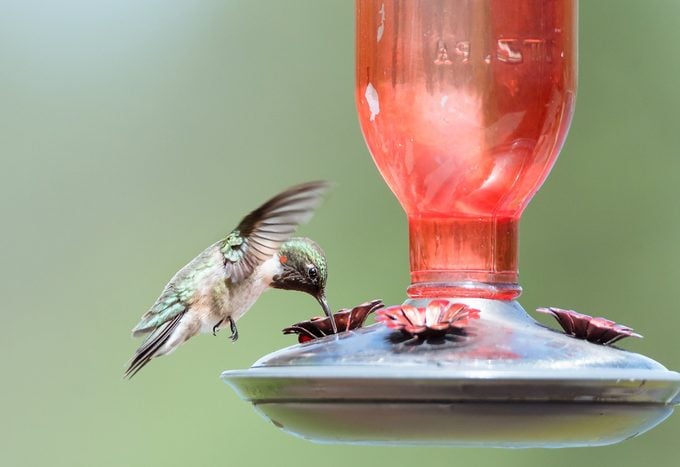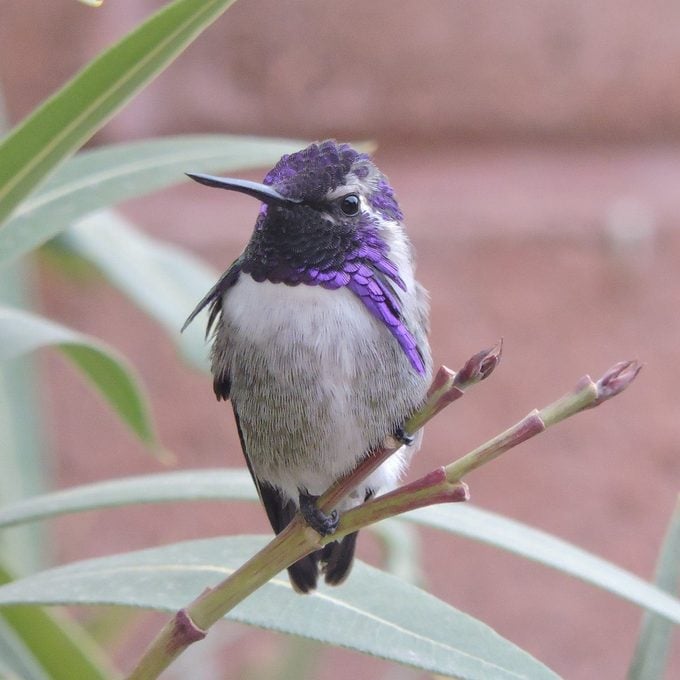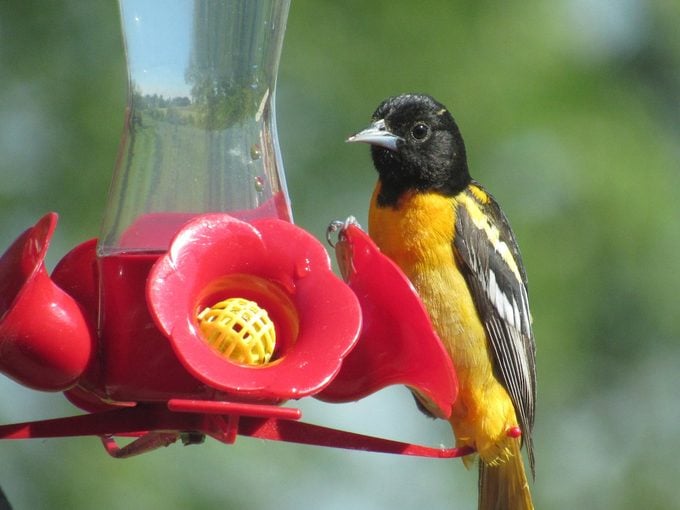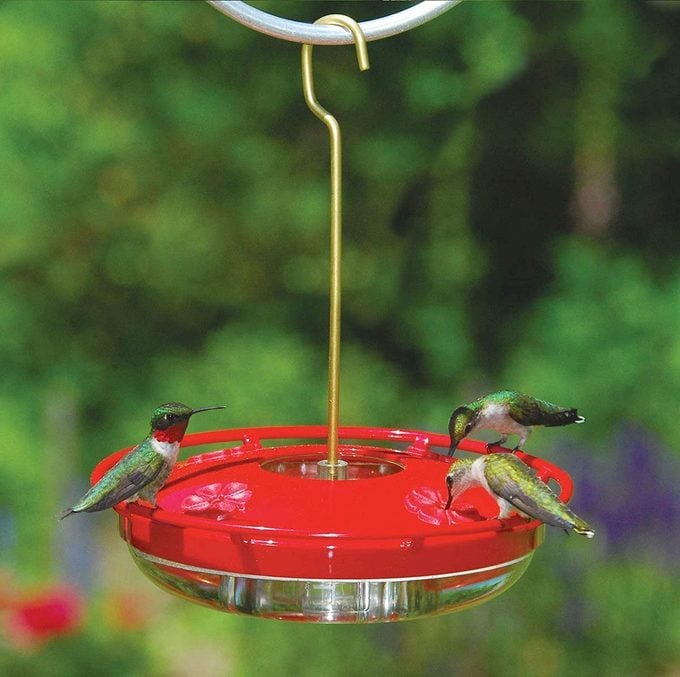14 Questions About Hummingbird Feeders Answered by Experts
Updated: Mar. 20, 2023
Get the answers to everything you've wondered about your hummingbird feeders, like what to put in a hummingbird feeder and where to hang your feeder.
Our editors and experts handpick every product we feature. We may earn a commission from your purchases.
The first time a hummingbird zips into your yard and stops at a hummingbird feeder is a thrilling moment. But being the keeper of a hummingbird feeder can be challenging, too. We get tons of questions from readers about what they’ve observed at their own feeders and been curious about, like what to put in hummingbird feeders, the best kind of hummingbird feeders to use, other birds that might drink the sugar water, why hummingbirds are not coming to the feeders, and how to keep yellow jackets away from feeders.
So we enlisted bird experts Kenn and Kimberly Kaufman to answer some of your hummingbird feeder questions, from the most common to the most quirky.

1. What Do You Put in a Hummingbird Feeder?
“I need to know what to put in a hummingbird feeder. I have heard that you should make sugar water strong for hummingbirds when they first arrive in spring. Is this true?” asks Evelyn Goodspeed of Witherbee, New York.
Kenn and Kimberly: When the hummingbirds first arrive in spring, it’s not necessary to sweeten up your recipe mixture. We always recommend mixing 1 cup of white granulated sugar with 4 cups of water. Boil it and then let it cool to help reduce impurities in the solution. You should steer clear of brown sugar, powdered sugar, honey, red dye, food coloring, or any other ingredient but plain white sugar.
2. What Are the Best Feeders for Hummingbirds?
“My hummingbird feeders never have visitors. What are the best feeders for hummingbirds to buy or build?” says Lothar Willertz of Sanford, Michigan.
Kenn and Kimberly: For the most part, hummingbirds aren’t picky, so the best feeder is the one you find easiest to fill, clean and hang. The traditional glass bottle that threads into a plastic basin works extremely well. We prefer the 30-ounce bottle because it’s more stable and doesn’t tip as easily when orioles drink from it. We also like the type with a shallow plastic basin where the lid with feeding ports snaps down over it.
Both are easy to clean, and that is important. Before giving up on the feeders, make sure you use the proper sugar water recipe of four parts water to one part sugar. If the mixture is too weak, birds won’t be interested.
3. Is Organic Sugar Better for Hummingbird Feeders?
“Hummingbirds refuse to eat the sugar water I make with organic sugar. Can you explain the difference between organic and white sugar?” asks Christine Davis of Ludlow, Massachusetts.
Kenn and Kimberly: Pure white table sugar is the safest option for mixing nectar for hummingbirds. Many consider organic sugar, which doesn’t tend to be fully refined to pure sucrose, unsafe for feeding birds.
Learn more about what foods hummingbirds eat.
4. How Can I Prevent Mold Growth in Hummingbird Feeders?
“How do you keep homemade hummingbird nectar from getting moldy?” writes Della Lansdell of Prattville, Alabama.
Kenn and Kimberly: We suggest mixing your own hummingbird sugar water, using 4 parts water to 1 part sugar, and bringing it to a full boil to break down the sugar completely. Once it’s cool, refrigerate what you don’t use between fillings. Avoid using red dye; the birds don’t need it, and it’s easier to monitor the freshness of colorless sugar water. Another way to avoid mold is to fill feeders only halfway and clean them before each refill. Placing your feeders in the shade will also help keep sugar water from spoiling too quickly.
Learn how to clean hummingbird feeders.
5. Where Should I Hang Hummingbird Feeders?
How should I hang my hummingbird feeder (height, location, etc.)?” asks Barent Parslow of Staunton, Virginia.
Kenn and Kimberly: Since they’re accustomed to hovering low in front of flowers, there’s no real height requirement for hummingbird feeders. Just make sure the feeder is in a place where it’s easy to see and enjoy! This will allow you to monitor it closely for filling and cleaning, too.

6. Why Do Finches Visit Hummingbird Feeders?
“Is it normal for house finches to drink sugar water?” writes Shannan Shade of Marshall, Wisconsin.
Kenn and Kimberly: Although hummingbirds are the only true nectar specialists in North America, many birds sample the sweet stuff when they get the chance. Once they learn to drink from hummingbird feeders, house finches may become regular visitors. The same is true of orioles and also the verdin, a southwestern desert bird. Other examples of surprising visitors include titmice, several warblers (including Cape May, pine and orange-crowned), goldfinches, mockingbirds, chickadees, and thrashers. Aside from birds, your sugar-water feeders also may attract nectar-feeding bats (in the Southwest), squirrels, and even bears if there happen to be any in your neighborhood.
Check out the best squirrel-proof bird feeders and 12 tips that work.
7. Will Hummingbirds Become Dependent on Feeders?
“We’re selling our house, and I’m concerned the new owners will not keep the hummingbird feeders filled. What will happen?” says Vincent Staley of Fredericksburg, Virginia.
Kenn and Kimberly: We appreciate your concern, but hummingbirds are adaptable and good at finding new places to live. In natural habitats, good concentrations of flowers may change over time. For example, a meadow filled with flowers one year may be overgrown with shrubs the next. Hummingbirds have to be able to move around and find new food sources. Of course, if you can talk to the new residents of your home, you could try to inspire them with stories about the magic of hummingbirds and tell them the rewards of keeping the feeders filled and clean.
Learn how hummingbirds use their tongues and beaks.
8. Are Hummingbirds Territorial?
“I never get more than one hummingbird at a time at my feeders. How can I encourage them to share?” asks Cheryl Vandermark of Wallkill, New York.
Kenn and Kimberly: Hummingbirds have an instinct to protect their food sources, because in nature, a patch of flowers will produce only so much nectar in a day. The tiny birds carry this defensiveness over to artificial feeders. The best way to keep one hummingbird from dominating a feeder is to put up several feeders in different spots. If some feeders can be out of sight from the others (around a corner, for example), it will be even harder for one bird to control them all. With multiple feeders available, even the most aggressive hummingbirds may give up and just share with others.
9. Why Do Hummingbirds Hang Upside Down at Feeders?
“I saw a hummingbird hanging upside down from my sugar-water feeder by one foot. As I neared, it flew away. What happened to it?” says Margaret Hocker of Metropolis, Illinois.
Kenn and Kimberly: Hummingbirds have a bizarre way of conserving energy. Usually at night, during periods of cold and sometimes when they’re perched at a feeder, hummingbirds can enter a deep, sleep-like state known as torpor, when all body functions slow dramatically. Metabolism slows by as much as 95%, and heart rate and body temperature drop significantly. Torpor allows them to conserve precious energy and survive surprisingly low temperatures. Hummingbirds are tough birds!
Learn where hummingbirds sleep at night.

10. Why Do I Never See Male Hummingbirds at My Feeders?
“I only have female ruby-throated hummingbirds visiting my sugar-water feeder and the flowers on my deck rail. I never see males. Do they like different flowers and the types of feeders than the females? asks Linda Anderson of Berwick, Pennsylvania.
Kenn and Kimberly: Males and females generally like the same things, so there may be other factors at work here. It’s possible that the male hummingbirds in your area have territories away from your feeders and flowers so you don’t see them as often. We’ve also seen females defending the territory around the nest, actively chasing off the males and other females that venture too close. Also, remember that juvenile hummingbirds (both males and females) look like the adult females, so they outnumber the flashy ruby-throated adult males.
Learn more about the life of a female hummingbird.
11. How Can I Keep Yellow Jackets Off Hummingbird Feeders?
“How can I keep yellow jackets away from my hummingbird feeders? says Gail Mitchell of Martinsville, Virginia.
Kenn and Kimberly: Reducing the ratio of sugar to water might help. Try 5 parts water to 1 part sugar, instead of the usual 4 to 1. Be sure to clean any spillage off the feeding ports. Since bees and wasps prefer to feed in sunny areas, you could try moving your feeders to a shadier area. Avoid using products such as pesticides, petroleum jelly or cooking oil on the feeding ports to discourage bees and wasps, since these substances can be deadly for hummingbirds. It’s also good to remember that these insects are important pollinators, and we should protect them, too.
Check out more natural ways to keep wasps away from hummingbird feeders.
12. Do Bees Make Hummingbird Feeders Dirtier?
“I have several sugar-water hummingbird feeders. Bees invade some of them. When I bring in the feeders for cleaning and refilling, the ones used by bees are usually dirtier. Why?” asks Ellen Gonzales of Dripping Springs, Texas.
Kenn and Kimberly: It’s hard for us to be sure without actually seeing the feeders involved, but we have some ideas. Bees only visit feeders where the sugar water is easy to reach—especially if it’s leaking or spilled on the outside. Even a very slow leak can make the feeders dirtier inside and out. Bees often carry pollen, and they may leave a light dusting of it on every visit to the feeder, adding to the mess. Check your feeders carefully for leaks, install bee guards on the openings, and consider switching to the dish feeder style in which the openings are raised well above the level of the sugar water.
Check out the best gifts for hummingbird lovers.

13. How Can I Keep Orioles Away from Hummingbird Feeders?
“How can I keep larger birds like orioles from monopolizing my hummingbird feeders?” says Roger Hatfield of Del Rio, Texas.
Kenn and Kimberly: In your region of Texas, you’re lucky to have several types of orioles, but we understand why you’d want to keep space open for hummingbirds. One approach is to have one or two “sacrificial” feeders, with perches that make it easy for orioles and other larger birds to drink sugar water. If you have other feeders with no perches, the hummingbirds can still hover at those to feed, ideally undisturbed by the larger birds.
14. Do Woodpeckers Drink From Hummingbird Feeders?
“A woodpecker stops at my hummingbird feeder every day. It sure has a sweet tooth! Is this common?” asks Lisa Bellando of Denville, New Jersey.
Kenn and Kimberly: This female downy woodpecker does seem to have a taste for the sweet stuff. We’ve seen this kind of thing in the Southwest, where almost every yard has hummingbird feeders, and Gila woodpeckers often learn to drink from them. Elsewhere the habit seems less common, but downies and other woodpeckers sometimes learn the trick of visiting these sugar-water feeders.
Next, discover jaw-dropping facts about hummingbirds.





















